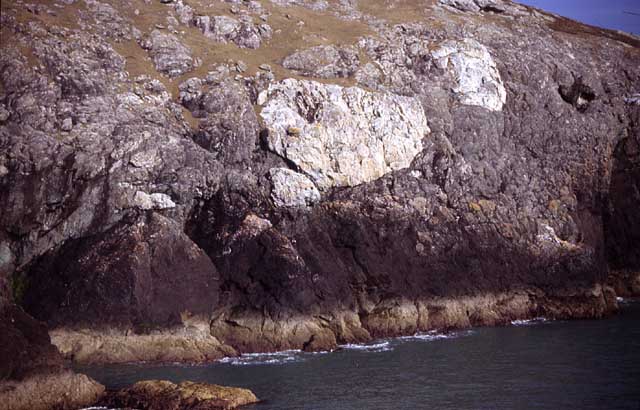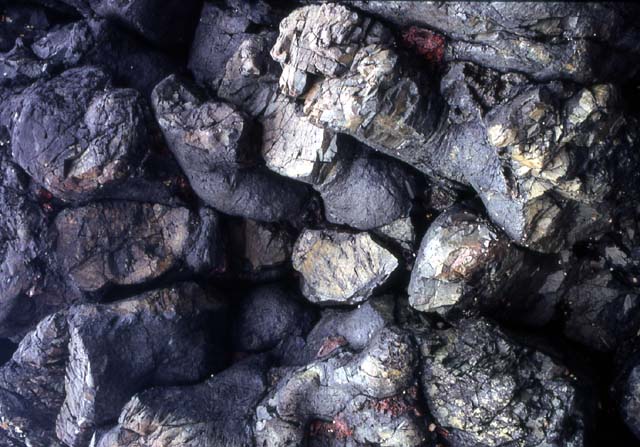SPRING
2006 - part 1: Out & about - Surrey, Dorset and some
weird rocks on the Llyn Peninsula!
BACK TO WEATHER-BLOG MENU
New! Fine Art Prints & digital
images for sale-
Welsh Weather & Dyfi Valley landscapes Slide-Library
- Click HERE
| Late
April saw a series of "missions" that
took me outside of my normal haunts, starting
with an appointment in deepest Surrey..... |
|
 This was the venue for a filming-session with BBC1's Countryfile programme as part of the launch of their 2006 photography competition - theme = "weather".... |
|
 I'd suggested the Devil's Punchbowl by the A3 at Hindhead as a venue (scenic, easy to reach from London etc). Wish I could have suggested some decent weather too! The day dawned misty, chilly and damp, and remained that way throughout the filming. Here's the production-team and Jo Brand, who was being assailed by a variety of artificial "weather" generated by the special-effects wizardry. She gets my vote for being such a good sport! Why not give this comp a try? Some cool prizes and good amounts of kudos too. For details of how to enter, see http://www.bbc.co.uk/nature/environment/programmes/countryfile/photocomp.shtml |
|
 A few days later saw me giving a seminar on TORRO down in Dorset. Gave me chance to have a wander along one of my childhood stamping-grounds - the beaches of the Jurassic Coast. Here's a shot of last winter's landslide at Charmouth... |
|
 ...while further east this high cliff of grey marls was not a place to linger beneath. You can't see the huge crack behind this several-hundred feet high pillar but I'd give this section less than 6 months before it comes down! |
|
 That evening took me to Abbotsbury with fishing gear - I'd heard mackerel were being caught off Chesil Beach there. This is looking east towards the amazing beach and the Fleet - the saltwater lagoon behind it, with both disappearing into the sea-fog that was gathering in the distance.... |
|
 Towards sunset I caught a few mackerel and got this pic! |
|
 Homeward bound at last and in late evening I was heading northwards out of Rhyader when I caught sight of these mid-level clouds with virga fall-streaks.... |
|
 ...and later on these lenticulars out to the west.... |
|
 By the time I got to the top of the pass the sun had just dropped below the horizon and I lingered to watch the colours change, deepen and slide slowly into night.... |
|
 ....this cirrus-field commanded a good bit of attention! |
|
 Slightly later, underexposed slightly to bring out the rich colour and silhouette the ground more! |
|
 The following weekend I went on a reconnaisance to the SW tip of the Llyn Peninsula and Bardsey Sound. I'd planned to lead a geological field-trip there so thought an up-to-date recce would be a good plan. It's a beautiful area, with Bardsey Island sitting on the sea across the raging 5 knot plus todes that pour through this narrow passage - no place for under-equipped boats! |
|
 ...and no places here and there for the unsteady! These grass slopes are a lot steeper than they look and would be a bit of a horror after rain, ending as they do in sheer cliffs... |
|
 Here's a good reason for visiting this locality....for scale, there are several anglers standing at the end of the point R! Can you see them? |
|
 Here is the interesting geology in close-up. These weird rocks are part of the Gwna Melange, which forms a lot of the N coast of the peninsula and also occurs on Anglesey. A melange is a huge, catastrophic underwater flow of debris. These white blobs (sorry, masses of quartzite) are individual fragments of debris - giant boulders in effect, tens of metres across. Some of these clasts in other parts of the melange can be over a kilometre across! Other clasts include pillow-basalts, banded charts, algal limestones and red mudstones. The melange is thought to have originally covered several thousand square kilometres and it is believed to have formed at a destructive plate-margin where an ancient sea-floor, including volcanic islands where shallow-water sediments were deposited, was being subducted under North Wales in a south-easterly direction. Big debris-flows are commonly found at subduction trenches. I like the description of the famous geologist Edward Greenly though. Greenly mapped Anglesey in the early part of the 20th Century and described the Gwna Melange as "quite indescribable"! Agewise it was thought to be late Precambrian although certain poorly-preserved microscopic fossils have been found which suggest it is of Cambrian age. Either way, it remains an enigmatic - and spectacular - deposit! |
|
 ...So, farewell to Bardsey and high hopes for the same glorious weather on my guided trip a couple of weeks later! |
|
 A couple of weeks later! This is the village of Porth Dinllaen near Nefyn in the northern Llyn. Blazing sunshine over Snowdonia - what had I done to deserve this? Low pressure sat over E England was responsible. Warm air in the low's circulation was drifting out over Liverpool Bay and being cooled by the chilly Irish Sea to the point that the moisture it contained was condensing out as fog and then drifting back onto land. Sea-fog on a supposedly scenic geological trip - aaaargghhh! |
|
 Luckily the geology at Porth Dinllaen is still good close-up. The whole headland is a raft of pillow-basalts - another giant clast within the Gwna Melange it is thought, and probably correlated with the famous pillow-lavas of Newborough on Anglesey. These are superb examples though! What happens when lava is erupted underwater is that it cools rapidly. These pillows form when the molten lava breaks through the thin walls of underwater lava-tubes. It then squeezes out like toothpaste into the water and quickly solidifies as these irregular, tongue-like protrusions. The process repeats itself time and again, so that the resulting protrusions stack one upon another as the undersea lava-flow advances along. The red stuff between the pillows (which incidentally are typically half to one metre across) is jasper, formed by the precipitation of silica and iron from hydrothermal fluids expelled from the volcanically active sea-bed. |
|
 Back down SW, meanwhile, the sea-fog won the day. Only after my field-party had departed did even a fraction of Bardsey Island start to show itself! The same party got attacked by an afternoon thunderstorm on their second day out. Two fairly unusual weather-phenomena (for Wales) in two days - that IS bad luck! |
|
BACK TO WEATHER-BLOG MENU New! Fine Art Prints & digital images for sale- Welsh Weather & Dyfi Valley landscapes Slide-Library - Click HERE |